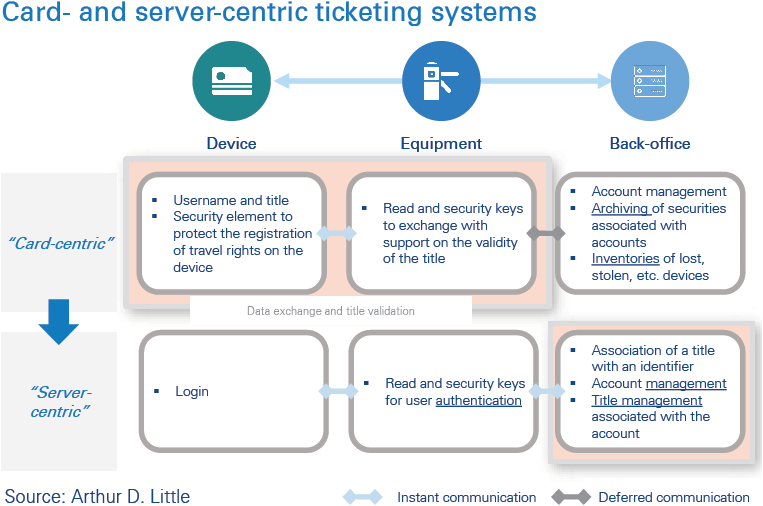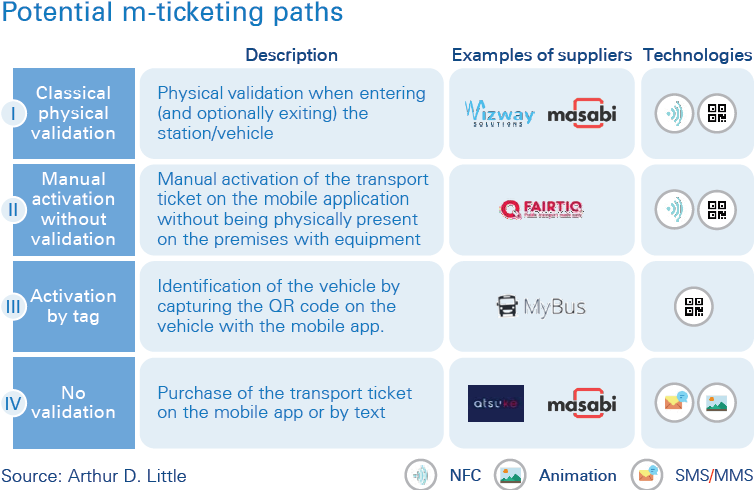
Transport authorities and mass transit operators should consider dematerialization of ticketing for increased resilience and to pave the way for Mobility-as-a-Service in a post-Covid world
Traditional card-centric ticketing technologies, with which every user is issued a physical ticket or token, have been in operation since the 1970s. In these closed-loop environments, the right to travel is encrypted directly onto a ticket’s magnetic stripe or the chip of a transport smartcard. It is then read and verified by heavy-duty equipment such as turnstiles in gated transport infrastructures (e.g., metro lines) and validators on buses and trams. Although they comply with strict security standards and protocols, these systems are questioned when it comes to costs (related to maintenance of ticketing equipment, management of cash and issuance of physical transport tickets), customer attractiveness (due to potentially outdated customer journeys) and the challenges of introducing innovation (such as development of new pricing schemes, account-based ticketing and introduction of new ticketing media, for example, smartphones or payment cards).
Transformative server-centric ticketing technologies have moved onto the radar of operators and transport authorities over the last 10 years. These rely on open-loop environments in which equipment reads IDs and then checks their validity with remote servers. This offers the opportunity to dematerialize the ticket more easily, as transport rights are no longer encrypted within the ticket itself, but outsourced to external servers. If this has been deployed by the transit agency, passengers can often pay and ride via contactless bank card (EMV/open payment) or smartphone (m-ticketing). As well as ease of use for consumers, server-centric solutions are flexible, support faster innovation, and lower equipment costs.
The benefits of dematerialized solutions
Whatever the ticketing architecture is, dematerializing transport tickets delivers three major benefits for public transport authorities and operators:
1 Improved customer experience
By removing the need to purchase, scan and retain a physical ticket, dematerializing makes the journey more seamless for the consumer, which improves the overall experience.
- Passengers can travel without transport-specific devices (such as physical tickets and travel-operator smartcards), relying instead on devices such as bank cards (EMV/open payment) and mobile phones (m-ticketing), which they carry around with them at all times.
- This benefits both frequent travelers, who do not need to physically buy or top up travel passes, and, more specifically, infrequent travelers, who no longer need to be educated on the system in place to access the transportation network.
- Additionally, by combining dematerialization with smartmobility services, users can plan routes, incorporating changes between modes of transport and providers.
2 Versatility and adaptability to enable innovation
The introduction of innovative pricing schemes (such as account-based ticketing and pay-as-you-go) is fostered by ticket dematerialization. Remote, back-end platforms consolidate transactions and offer the ability to bill customers once their trips are done – for example, on a daily basis.
Server-centric ticketing can support multiple technologies for storing and validating tickets, now and in the future. Tickets can be validated through bank cards, e-wallets, smartphones, smartwatches and biometry, as long as the field equipment can read such “IDs”.
3 Greater efficiency, higher revenues
Through improved customer experience, dematerialization also offers the opportunity to widen the addressable market (mainly to include occasional travelers), as well as optimize the cost structure. This is thanks to less pressure on ticket vending machines and operations related to cash collection and ticket issuance.
4 Less contact, more safety
The recent COVID-19 outbreak considerably challenges old ticketing-system architectures. Some public transport operators temporarily abandoned physical ticketing to limit interactions with materials (ticket vending machines and validators) and drivers and, indeed, renounced collecting revenues for safety reasons. Dematerialized ticketing simply eliminates the physical interactions required to buy tickets and validate them in transit.
To demonstrate this, Transport for London (TfL) saw the following benefits after introducing open payment in 2014
- Efficiency – it reduced the cost of collecting fares from 14 to 9 percent of revenues.
- Customer experience – more than 850 million journeys have been completed since 2014.
- Catering for occasional users – 19 million unique contactless cards or payment devices have been used in more than 100 countries around the world.
Overcoming the challenges to widespread adoption
Current penetration of dematerialized ticketing is not deep within transit systems. This is for three main reasons:
Open payment and m-ticketing
Open payment: The passenger validates a contactless bank card when beginning their journey, and again when finishing it (if required). Billing is direct from the bank/credit card account and can be on a fixed or variable/aggregated model. Operators require front-end validation equipment compatible with the Europay, Mastercard, Visa (EMV) security standard, Payment Card Industry Data Security Standard (PSI DSS)-certified equipment, contracts with acquiring banks to aggregate transactions, and contracts with payment processors.
M-ticketing: The passenger uses a mobile phone (or a wearable such as a smartwatch) as a channel to buy and validate the ticket. Multiple technologies (NFC, QR codes, SMS or animation) can be used for each transaction, as described below. The majority of m-ticketing schemes currently rely on NFC or QR codes.
1 The limitations of “traditional” infrastructure
There is high interdependency between media, systems and equipment in traditional ticketing systems. Legacy equipment in card-centric environments is not designed to incorporate technologies required to support the main dematerialization options. Adopting open payment and m-ticketing therefore requires retrofitting equipment, such as enhancing the system infrastructure to make it compliant with EMV standards. Transit agencies must conduct opportunity studies to ensure the costs of these do not exceed incremental benefits. Parallel architectures for fare calculation and account management may need to be added, which will increase integration and management costs.
2 CAPEX cycles
The development of ticketing systems has been mainly CAPEXbased, with long periods of amortization that are disconnected from technological upgrades. The “reinvestment” required by systems enhancement may be out of investment cycles, while the introduction of m-ticketing is more suitable to OPEX-based business models.
Massachusetts Bay case study
The Massachusetts Bay Transportation Authority introduced m-ticketing through QR codes on its network of 140 commuter train stations in 2012, utilizing technology from Masabi. Passengers pay with their mobiles, with QR codes inspected on trains by control agents. In four years, penetration rose to nearly half (49 percent) of all fares, with a 40 percent drop in sales via ticket machines and a 25 percent fall in on-train cash purchases, all of which decreased costs. Revenue grew by 33 percent during the same period, which showed the increase in utilization.
3 Limited security track record
The card-centric environment built its own success thanks to high levels of security and robustness, which is a must-have when dealing with millions of validations and transactions per day. Conversely, mobile technologies’ lack of track record can impede large-scale adoption, notably for subscription-based products.
Options for current and future innovation
In spite of the constraints developed above, there are still paths and technologies that could be adopted to make dematerialization possible.
1 Within card-centric architectures
There are broadly two options – building upon the core infrastructure or implementing alternative paths with parallel technology:
Building upon the existing infrastructure:
- Cards/tickets can be virtualized through NFC technology within a secured element, which can be embedded in the phone hardware or SIM card, or emulated by software.
- Suitable for gated environments and reasonable equipment retrofits, this technology is attractive to large public networks that combine metro, trams and buses. It has been adopted by the Ile de France region, which uses solutions powered by Wizway.
- However, deployment of NFC technology is limited in iOS environments because commercial and technological agreements with Apple are necessary. This considerably constrains its market reach.
- In France, IdFM, the transport authority of the Paris region, embraced an ambitious program to implement account-based ticketing and introduce new ticketing media. The “Ticketing Modernization Program” should enable regular and occasional clients to use smartphones to buy short and long products. IdFM will also eventually release a post-payment product called “Navigo Liberté +”, with which the client will have the option to be billed at the end of the month based on public transport rides.
- Making open payment possible in card-centric environments is also possible. TfL, with the support of Mastercard and Cubic, designed and implemented a system upgrade to welcome contactless payment technology; local challenges related to traffic expansion certainly helped make the business case profitable.
Other technologies using parallel paths are also available:
- Visual validation technologies: Visual validation can be used via smartphone. This could be a ticket sent via SMS (as provided for instance by Atsuke), with invoicing through the mobile operator. Alternatively, the passenger can be sent a regularly changing animation, such as a picture that essentially acts as a password. The driver or inspector physically checks that the picture matches the current, approved animation before allowing travel. This system has been deployed in 20 cities in Europe, and piloted on buses in Paris.
- Passive tags: Operators can deploy passive tags on buses, validated by Bluetooth to the passenger’s smartphone (as provided for instance by MyBus). The consumer is then billed directly via a dedicated app, essentially through a parallel architecture to the existing card-centric environment. This approach is best suited to medium-sized cities with relatively small numbers of daily passengers. MyBus’s solution has been adopted in locations across France, including Arles, Clermont-Ferrand and Moulins.
- Manual activation without validation: This works well in open transportation systems without barriers. Users simply declare themselves active on a network through a location-based app, which then tracks their journeys and applies charges at the end of the day. One of the most-used providers of this type of technology is FAIRTIQ, which can be used throughout Switzerland for all public transport journeys, such as on SBB’s national railways and within the city of Lausanne.
2 Within server-centric architectures
Introducing new dematerialized ticketing is easier within server-centric architectures because they remove the need for physical tickets or tokens. QR-code technology has gained traction over the last years thanks to its cost-competitiveness, particularly in Asia. The customer journey remains the same, with the passenger scanning the QR when passing through turnstiles, at validators on bus/tram platforms, or at entrances to transport carriages. Public transport authorities developing server-centric architectures also tend to heavily use openpayment technologies, which removes the need to buy tickets, validate the payment card, and use the digital wallet to perform transactions and as a source of billing.
In New York, the MTA will roll out the OMNY (One Metro New York) program by 2023, which aims to enable passengers to use contactless cards or smart devices to make fare payments and enter the system. Anyone who registers with the OMNY program will be given a secure and personalized dashboard, as well as access to trip history and the ability to manage payment media.
Unlocking opportunities for all stakeholders
Dematerialization of ticketing is a logical evolution within mass transit networks, as it allows the further digitalization of offerings and - along with the development of suitable data architecture - it constitutes a key requirement for the development of Mobility-as-a-Service (MaaS) with public transport as a backbone. The dematerialization of ticketing is thus critical for mobility stakeholders along the value chain to further unlock opportunities:
Transport authorities should consider dematerialization of ticketing as a forward looking opportunity to develop superior client experience (meeting evolving client needs) and to further increase the resilience of mass transit systems.
Mass transit operators should assess opportunities to drive superior client experience by upgrading their ticketing capabilities, and making a sound assessment of available technologies that best fit their networks.
Ticketing solution providers should seize business opportunities by broadening their product portfolio of dematerialized ticketing technologies to cover the differentiated needs of PTOs.










